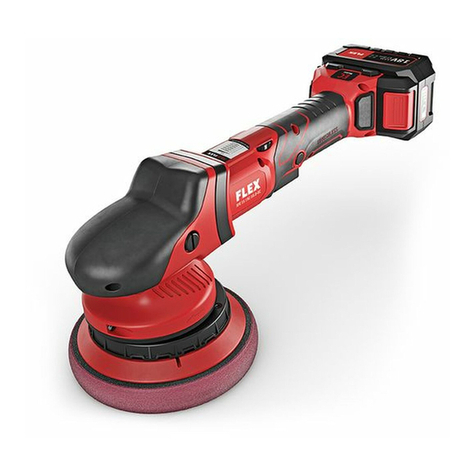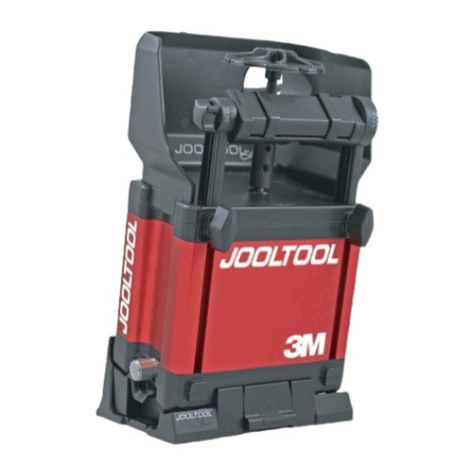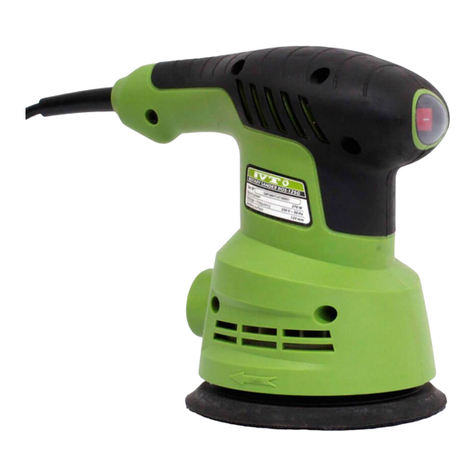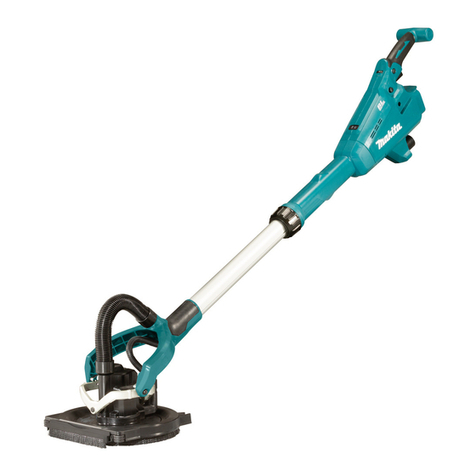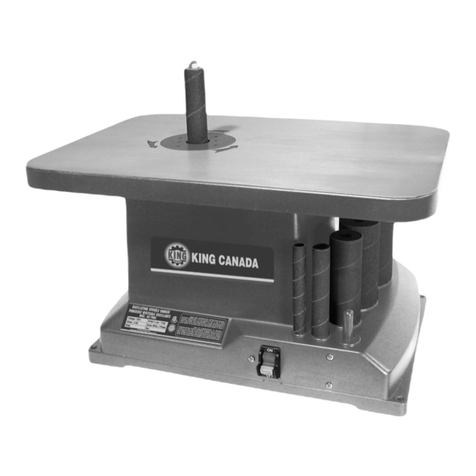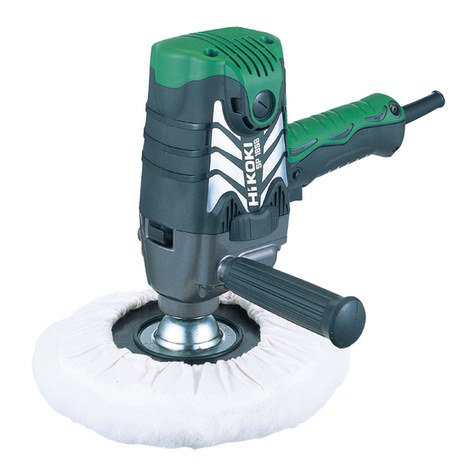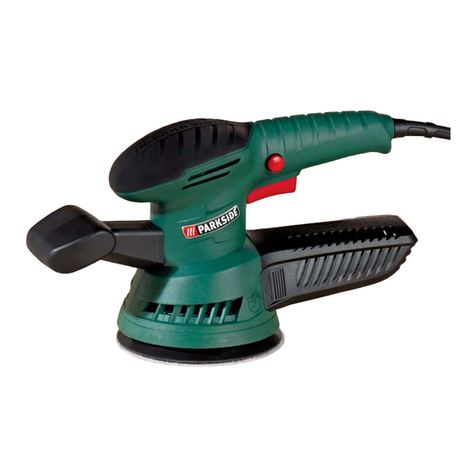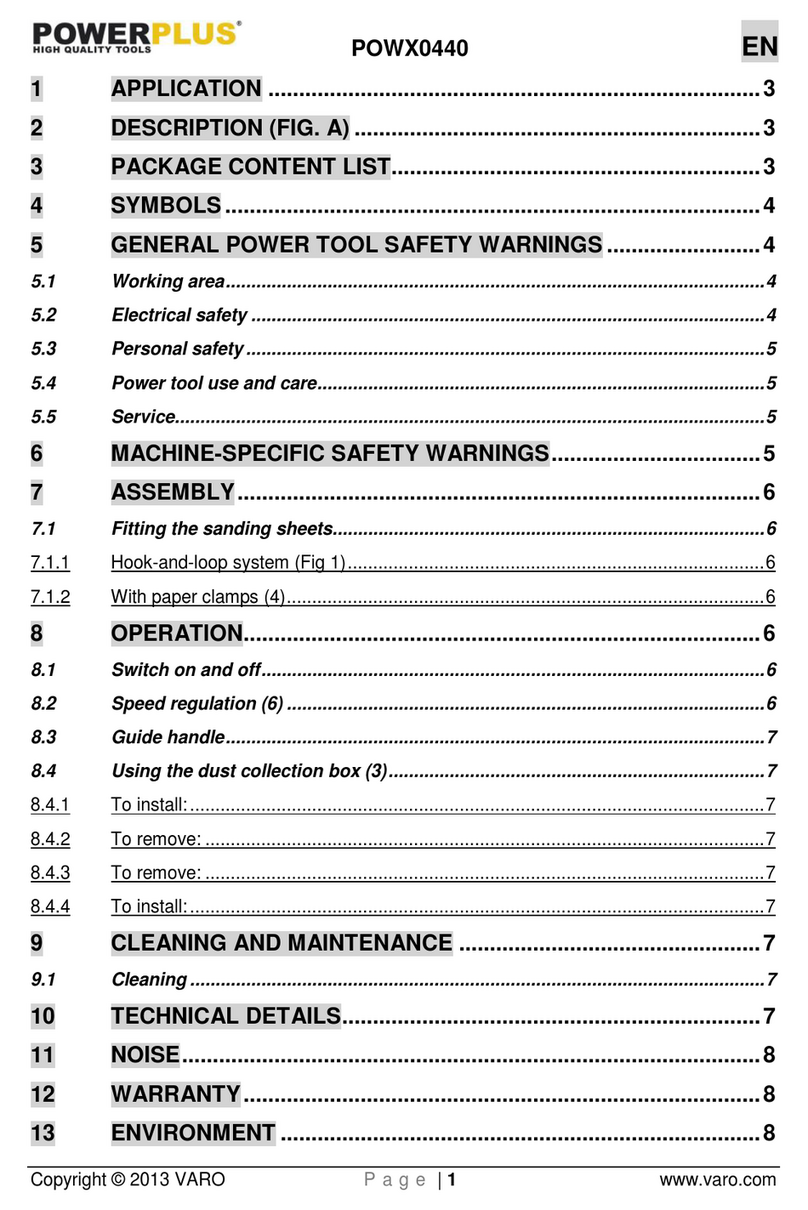Jepson 3405 User manual

KO SHIN ELECTRIC & MACHINERY CO., LTD.
LIN-KOU 4TH INDUSTRIAL PARK NO.33, DING-HU ROAD, KWEISHAN, TAOYUAN 333,TAIWAN
Part no. 2905307

GENERAL SAFETY RULES
WARNING!
READ AND UNDERSTAND ALL INSTRUCTIONS. Failure to
follow all instructions
listed below, may result in electric shock, fire and/or serious personal injury.
"SAVE THESE INSTRUCTIONS"
1. WORK AREA
1.1 KEEP YOUR WORK AREA CLEAN AND
WELLLIT. Cluttered benches and dark areas
invite accidents.
1.2 DO NOT OPERATE POWER TOOLS IN
EXPLOSIVE ATMOSPHERES, SUCH AS IN
THE PRESENCE OF FLAMMABLE LIQUIDS,
GASES, OR DUST. Power tools create
sparks, which may ignite the dust or fumes.
1.3 KEEP BYSTANDERS, CHILDREN, AND
VISITORS AWAY WHILE OPERATING A
POWER TOOL. Distractions can cause you to
lose control.
2. ELECTRICAL SAFETY
2.1 DOUBLE LNSULATED TOOLS ARE
EQUIPPED WITH A POLARIZED PLUG
(ONE BLADE IS WIDER THAN THE
OTHER.) THIS PLUG WILL FIT IN A
POLARIZED OUTLET ONLY ONE WAY. IF
THE PLUG DOES NOT FIT FULLY IN THE
OUTLET, REVERSE THE PLUG. IF IT STILL
DOES NOT FIT, CONTACT A QUALIFIED
ELECTRICIAN TO INSTALL A POLARIZED
OUTLET. DO NOT CHANGE THE PLUG IN
ANY WAY. Double insulation eliminates
the need for the three wire grounded power
cord and grounded power supply system.
2.2AVOID BODY CONTACT WITH GROUNDED
SURFACES SUCH AS PIPES, RADIATORS,
RANGES AND REFRIGERATORS. There is
an increased risk of electric shock if your body
is grounded.
2.3 DON’T EXPOSE POWER TOOLS TO RAIN
OR WET CONDITIONS. Water entering a
power tool will increase the risk of electric
shock.
2.4 DO NOT ABUSE THE CORD. NEVER USE
THE CORD TO CARRY THE TOOLS OR
PULL THE PLUG FROM AN OUTLET. KEEP
CORD AWAY FROM HEAT, OIL, SHARP
EDGES OR MOVING PARTS. REPLACE
DAMAGED CORDS IMMEDIATELY.
Damaged cords increase the risk of electric
shock.
2.5 WHEN OPERATING A POWER TOOL
OUTSIDE, USE AN OUTDOOR EXTENSION
CORD MARKED ”W-A”OR “W.” These
cords are rated for outdoor use and reduce the
risk of electric shock.
Recommended Minimum Wire Gauge
for Extension Cords
3. PERSONAL SAFETY.
3.1 STAY ALERT, WATCH WHAT YOU ARE
DOING AND USE COMMON SENSE WHEN
OPERATING A POWER TOOL. DO NOT
USE TOOL WHILE TIRED OR UNDER THE
INFLUENCE OF DRUGS, ALCOHOL, OR
MEDICATION. A moment of inattention while
operating power tools may result in serious
personal injury.
3.2 DRESS PROPERLY. DO NOT WEAR LOOSE
CLOTHING OR JEWELRY. CONTAIN LONG
HAIR. KEEP YOUR HAIR, CLOTHING, AND
GLOVES AWAY FROM MOVING PARTS.
Loose clothes, jewelry, or long hair can be
caught in moving parts.
3.3 AVOID ACCIDENTAL STARTING. BE SURE
SWITCH IS OFF BEFORE PLUGGING IN.
Carryingtools withyour fingeron theswitch or
plugging in tools that have the switch on invites
accidents.
3.4 REMOVE ADJUSTING KEYS OR
SWITCHES BEFORE TURNING THE TOOL
ON. A wrench or a key that is left attached to
a rotating part of the tool may result in
personal injury.
3.5 DO NOT OVERREACH. KEEP PROPER
FOOTING AND BALANCE AT ALL TIMES.
Proper footing and balance enables better
control of the tool in unexpected situations.
3.6 USE SAFETY EQUIPMENT. ALWAYS WEAR
EYE PROTECTION. Dust mask, non-skid
safety shoes, hard hat, or hearing protection
must be used for appropriate conditions.
4. TOOL USE AND CARE
4.1 USE CLAMPS OR OTHER PRACTICAL
WAY TO SECURE AND SUPPORT THE
WORKPIECE TO A STABLE PLATFORM.
Holding the work by hand or against your
body is unstable and may lead to loss of
control.
4.2 DO NOT FORCE TOOL. USE THE
CORRECT TOOL FOR YOUR
APPLICATION
. The correct tool will do the job
better and safer at the rate for which it is
designed.
4.3 DO NOT USE TOOL IF SWITCH DOES NOT
TURN IT ON OR OFF.
Any tool that cannot be
controlled with the switch is dangerous and
must be repaired.
4.4 DISCONNECT THE PLUG FROM THE
POWER SOURCE BEFORE MAKING ANY
ADJUSTMENTS,CHANGING
ACCESSORIES, OR STORING THE TOOL.
Such preventive safety measures reduce the
risk of starting the tool accidentally.
4.5 STORE IDLE TOOLS OUT OF REACH OF
CHILDREN AND OTHER UNTRAINED
PERSONS. Tools are dangerous in the
hands of untrained users.
4.6 MAINTAIN TOOLS WITH CARE. KEEP
CUTTING TOOLS SHARP AND CLEAN.
Properly maintained tools, with sharp cutting
edges are less likely to bind and are easier to
control.
4.7 CHECK FOR MISALIGNMENT OR
BINDING OF MOVING PARTS, BREAKAGE
OF PARTS, AND ANY OTHER CONDITION
THAT MAY AFFECT THE TOOLS
OPERATION. IF DAMAGED, HAVE THE
TOOL SERVICED BEFORE USING. Many
accidents are caused by poorly maintained
tools.
4.8 USE ONLY ACCESSORIES THAT ARE
RECOMMENDED BY THE MANUFACTURER
FOR YOUR MODEL.Accessories that may be
suitable for one tool, may become hazardous
when used on another tool.
5. SERVICE
5.1 TOOL SERVICE MUST BE PERFORMED
ONLY BY QUALIFIED REPAIR
PERSONNEL. Service or maintenance
performed by unqualified personnel could
result in a risk of injury.
5.2 WHEN SERVICING A TOOL, USE ONLY
IDENTICAL REPLACEMENT PARTS.
FOLLOW INSTRUCTIONS IN THE
MAINTENANCE SECTION OF THIS
MANUAL.
Use of unauthorized parts or failure
to follow Maintenance instructions may create
a risk of electric shock or injury.
WARNING
Check the outlet voltage to be sure it matches the voltage listed on the unit’s
nameplate. Using your tool at voltages more than 10% greater is potentially
dangerous and constitutes misuse. This includes using voltage boosters.
-
1
-
Nameplate
Amperes
Extension Cord Length
More
than
Not
more
than
0’-25’
26’-50’
51’-100’
101’-150’
06
18 16 16 14
610
18 16 14 12
10
12
16 16 14 12
12
16
14 12 -- --
-
2
-

RÈGLES DE SÉCURITÉGÈNÈRALES
AVERTISSEMENT!
Vous devez lire et comprendre toutes les instructions. Le non-respect, mê
me
partiel, des instructions ci-après entraîne un risque de choc électrique. d’
incendie et/ou
de blessures graves.
"CONSERVEZ CES INSTRUCTIONS"
1. Aire de travail
1.1 Veillez à ce que l’aire de travail soit
propre et bienéclairée. Le désordre et le
manque de lumiére favorisent les accidents.
1.2 N’utilisez pas d’outils électriques dans une
atmosphère explosive, par exemple en
présence de liquides, de gaz ou de
poussières inflammables. Les outils
électriquescréent des étincelles qui
pourraient enflammer les poussières ou les
vapeurs.
1.3 Tenez à distance les curieux, les entants
et les visiteurs pendant que vous
travaillez avec un outilélectrique. lls
pourraient vous distraire et vous taire faire
une fausse manoeuvre.
2. Sécuritéélectrique
2.1 Les outils à double isolation sont é quipés
d’une tiche polarisée (une des lames est
plus large que l’autre), qui ne peut se
brancherqued’une seule taçon dans une
prise polarisée. Si la tiche n’entre pas
parfaitement dans la prise, inversez sa
position ; si elle n’
entre toujours pas bien,
demandez à unélectricienqualitié
d’installer une prise de courant polarisée.
Ne modifiez pas la tiche de l’outil.La
double isotation [[ISYMBOLE!]] élimine le
besoin d’un cordon d’alimentation à trois fits
avec mise à la terre ainsi que d’une prise de
courant mise à la terre.
2.2 Évitez tout contact corporel avec des
surtaces mises à la terre (tuyauterie,
radiateurs,cuisinières,rétrigérateurs,
etc.) Le risque de chocélectrique est plus
grand si votre corps est en contact avec la
terre.
2.3 N’exposez pas les outilsélectriques à la
pluie ou à l’eau. La présence d’eau dans un
outil électrique augmente le risque de choc
électrique.
2.4 Ne maltraitez pas le cordon. Ne
transportez pas l’outil par son cordon et
ne débranchez pas la tiche en tirant sur le
cordon. N’exposez pas le cordon à la
chaleur, à des huiles, à des arêtes vives
ou à des pièces en mouvement.
Remplacez immédiatement un cordon
endommagé. Un cordon endommagé
augmente le risque de chocélectrique.
2.5 Lorsque vous utilisez un outilélectrique à
l’extérieur, employez un prolongateur
pour l’extérieurmarqué<<W-A>> ou
<<W>>. Ces cordons sont faits pour être
utilisés à l’extérieur et réduisent le risque de
chocélectrique.
3. Sécuritédes personnes
3.1 Restez alerte, concentrez-vous sur votre
travail et taites preuve de jugement.
N’utilisez pas un outiléle ctrique si vous
êtes fatiguéou sous l’influence de
drogues, d’alcool ou de médicaments. Un
instant d’inattention suffit pour entraîner des
blessures graves.
3.2 Habillez-vous convenablement. Ne portez
ni vêtements flottants ni bijoux. Confinez
les cheveux longs. N’approchez jamais
les cheveux, les vêtements ou les gants
des pièces en mouvement. Desvêtements
flottants, des bijoux ou des cheveux longs
risquent d’ê tre happée par des pièces en
mouvement.
3.3 Métiez-vous d’undémarrage accidentel.
Avant de brancher l’outil, assurez-vous
que son interrupteur est sur ARRÊT. Le
fait de transporter un outil avec le doigt sur
la détente ou de brancher un outil don’t
l’interrupteur est en position MARCHE peut
mener tout droit à un accident.
3.4 Enlevez les clés de réglag
e ou de serrage
avant de démarrer l’outil. Une clélaissée
dans une piècetournante de l’outil peut
provoquer des blessures.
3.5 Ne vous penchez pas trop en avant.
Maintenez un bon appui et restez en
équilibre en tout temps. Un bonne stabilité
vous perrnet de mieux réagir à une situation
inattendue.
3.6 Utilisez des accessoires de sécurité.
Portez toujours des lunettes ou une
visière.Selon les conditions, portez aussi
un masque antipoussière, des bottes de
sécuritéantidérapantes, un casque
protecteur et/ou un apparell antibruit.
4. Utilisation et entretien des outils
4.1 Immobilisez le matériau sur une surface
stable au moyen de brides ou de toute
autretaçon adéquate.Le fait de tenir la
pièce avec la main ou contre votre corps
offre une stabitlté insuffisante et peut
amener un dérapage de l’outil
4.2 Ne forcez pas l’outil. Utilisez l’outil
appropriéà la tâche.L’outil correct
fonctionne mieux et de façon plus
sécuritaire. Respectez aussi la vitesse de
travail qui lui est propre.
4.3 N’utilisez pas un outil si son interrupteur
est bloqué.Un outil que vous ne pouvez
pas commander par son interrupteur est
dangereux et doit êtreréparé.
4.4 Débranchez la fiche de l’outil avant
d’effectuerunréglage, de changer
d’accessoire ou de ranger l’outil.
De telles
mesures préventives de réduisent le risque
de démarrage accidentel de l’outil.
4.5 Rangez les outils hors de la portée des
entantsetd’autres personnes
inexpérimentées.Les outils sont
dangereux dans les mains d’utilisateurs
novices.
4.6 Prenez soin de bien entretenir les outils.
Les outils de coupe doiventêtre
toujoursbienaffûtésetpropres. Des
outils bien entretenus, don’t les arêtes sont
bien tranchantes, sont moins susceptibles
de coincer et plus taclles à diriger.
4.7 Soyez attentit à tout désalignement ou
coincement des pièces en mouv
ement, à
tout bris ou à toute autre condition
préjudiciable au bonfonctionnement de
l’outil. Si vous constatez qu’un outil est
endommagé,taites-leréparer avant de
vousenservir. De nombreux accidents
sontcausés par des outils en mauvaisêtat.
4.8 N’utilisez que des accessoires que le
tabricant recommande pour votre
modèle d’outil. Certains accessoires
peuvent convenir à un outil, maisêtre
dangereux avec un autre.
5. RÈPARATION
5.1 La réparation des outilsélectriques doit
êtrecontiée à un réparateur qualitié .
L’entretien ou la réparatîon d’un outil
électrique par un amateur peut avoir des
conséquences graves.
5.2 Pour la réparation d’un outil, n’employez
que des pièces de rechange d’origine.
Suivez ies directives données à la
section << Réparation>> de ce manuel.
L’emploi de pièces non autorisées ou le
non-respect des instructions d’entretien
peut créer un risque de chocélectrique ou
de blessures.
-3--4-

SPECIFIC SAFETY RULES AND/OR SYMBOLS
13.Use the specified surface of the wheel to
perform the grinding.
14.Watch out for flying sparks. Hold the tool so
that sparks fly away from you and other
persons or flammable materials.
15.
Do not leave the tool running. Operate the
tool only when hand-held.
16.Do not touch the work-
piece immediately after
operation;it may be extremely hot and could
burn your skin.
17.The label on your tool may include the
following symbols.
V--------------
volts
A--------------
amperes
Hz --------------
hertz
W--------------
watt
kg --------------
kilograms
min --------------
minutes
~--------------
Alternatingcurrent
no--------------
no load speed
--------------
Class ll Construction
…/min --------------
Revolutions or
reciprocation per minute
--------------
safety alert symbol
1.Always use proper
guard with grinding
wheel.
A guard protects operator from broken
wheelfragments.
2.Accessories must be rated for at least the
speed recommended on the tool warning
label.
Wheels and other accessories running
over rated speed can fly apart and cause
Injury.
3.Hold tool by insulated gripping surfaces
when performing an operation where the
cutting tool may contact hidden wiring or its
own cord. Contact with a “live”
wire will make
exposed metal parts of the tool “live”
and shock
the operator.
4. Keep guards in place.
5. Use only wheels having a maximum operating
speed at least as high as “NO LOAD RPM”
marked on the tool’s nameplate. When using
depressedcenterwheels,be sure to use only
fiber glass-reinforcedwheels.
6.
Check the wheel carefully for any crack or
damage before operation. Replace cracked
or damaged wheel immediately.
7. Use only flanges specified for this tool.
8. Be careful not to damage the spindle,the
flange (especially the installing surface) or the
lock nut. Damage to these parts could result in
wheel breakage.
9. Hold the tool firmly.
10. Keep hands away from rotating parts.
11.
Make sure the wheel is not contacting the
workpiece before the switch is turned on.
12. Before using the tool on an actual workpiece,
let it run for a while. Watch for vibration or
wobbling that could indicate poor installation
or a poorly balanced wheel.
●
Utilisez toujours un protecteur de meule
approprié.Le protecteur arrête les é
ctats en
cas de bris de la meule.
●Les accessoires doivent être pré
vus pour
au moins la vitesse recommandé
e sur
l’é tiquette de mise en garde de l’outil.
Les
meules et autres accessoires, s’
ils tournent
au-
dela de la vitesse nominale, risquent
d’é clater et de provoquer des blessures.
●Tenez l’outil par ses surfaces de prise
isolées pendant toute opération o?l’outil
de coupe pourrait venir en contact avec
un câblagedissimuléou avec son propre
cordon. En cas de contact avec un
conducteur sous tension, les pièces’
métalliques à découvertde l’outil
transmettralent un choc électrique à
l’utillsateur.
FUNCTION DESCRIPTION
Switch Action
To start the tool, simply pull the trigger. For continuous
operation without keeping your finger on the trigger, just
pull the trigger and then push in the lock button with your
thumb. To stop the tool from the lock position simply pull
the trigger again and release it. (FIG.1)
FIG.1.
Do Not Store the Tool with the Switch LockedOn To do so will cause the tool to start immediately in
the next time it is plugged in. Damage or personal injury may result.
CAUTION:Before plugging in the tool,always check to see that the switch actuates properly and
returns to the“OFF”position when released.
TOOLASSEMBLY
Installing Side Handle
Side handle should always be used during operation. Screw the side handle on the tool securely.
Installing or Removing Abrasire Disc
CAUTION:Always be sure that the tool is switched off and unplugged before installing or removing disc.
Always unplug the tool before installing or removing an
abrasive disc
(FIG.2)
FIG.2
-5-
△
!
-6-

When installing the abrasive disc. grip the edge of
the pad with your hand then tighten the screw
right(clockwise)with a hex wrench (FIG.3)
To remove the disc,follow the installation
procedure in reverse.
OPERATION
Grinding
In general, keep the edge of the sanding
disc at an
angle of about 10°~ 15°in relation to the workpiece
surface.
Choose a sanding disc with the right grit(grade) for
the right job. (Fig.4)
MAINTENANCE
CAUTION:
Be sure that the tool is switched OFF and UNPLUGGED before attempting to perform maintenance and
inspection.
To maintain product SAFETY and RELIABILITY,repairs,any other maintenance or adjustment should
be performed by Jepson Authorized Service Centers,always use Jepson replacement parts.
Replacing Carbon Brushes
1. Replace ca
rbon brushes when they wear down to
about 3/16”
(5mm)(FIG. 5) or sparking will occur.
Both brushes should be changed at the same time.
2.
Remove the screws on the case, then lift the
housing.
3.
Pull out the brush holder together with the carbon
brushes.
FIG.5
-8-
-
9
-
-7-
Table of contents
Languages:
Other Jepson Sander manuals
Popular Sander manuals by other brands
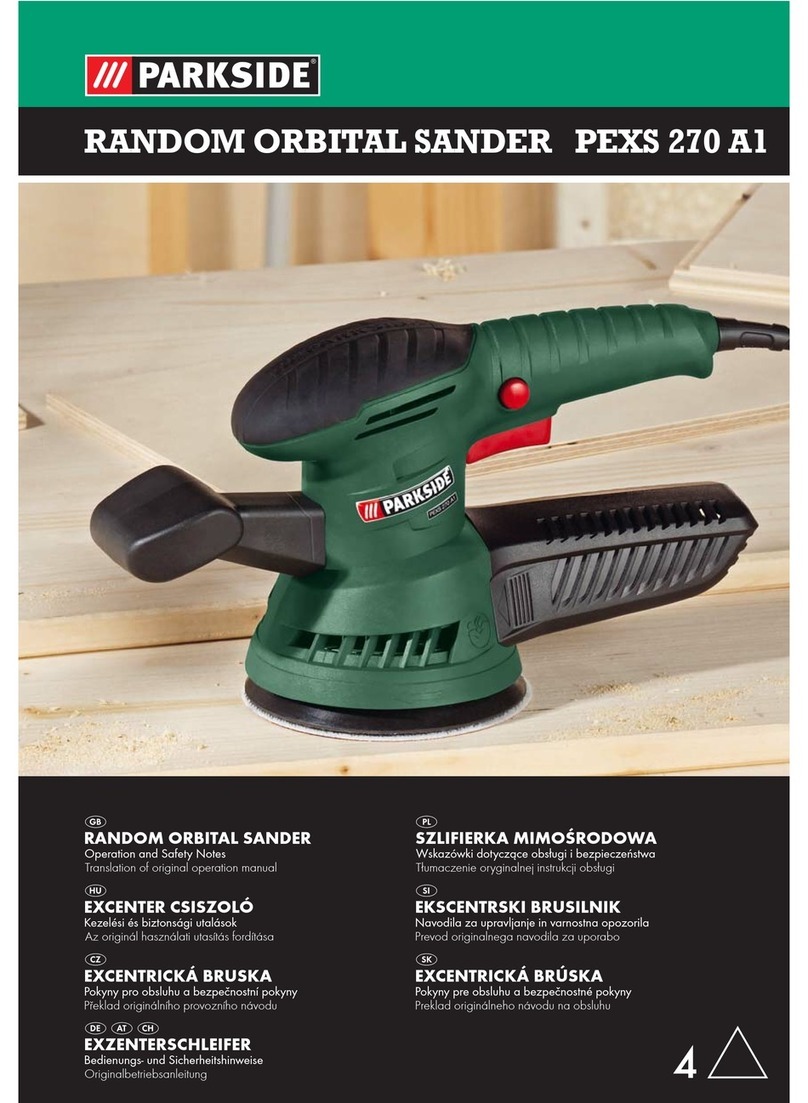
Parkside
Parkside PEXS 270 A1 - 4 Operation and safety notes
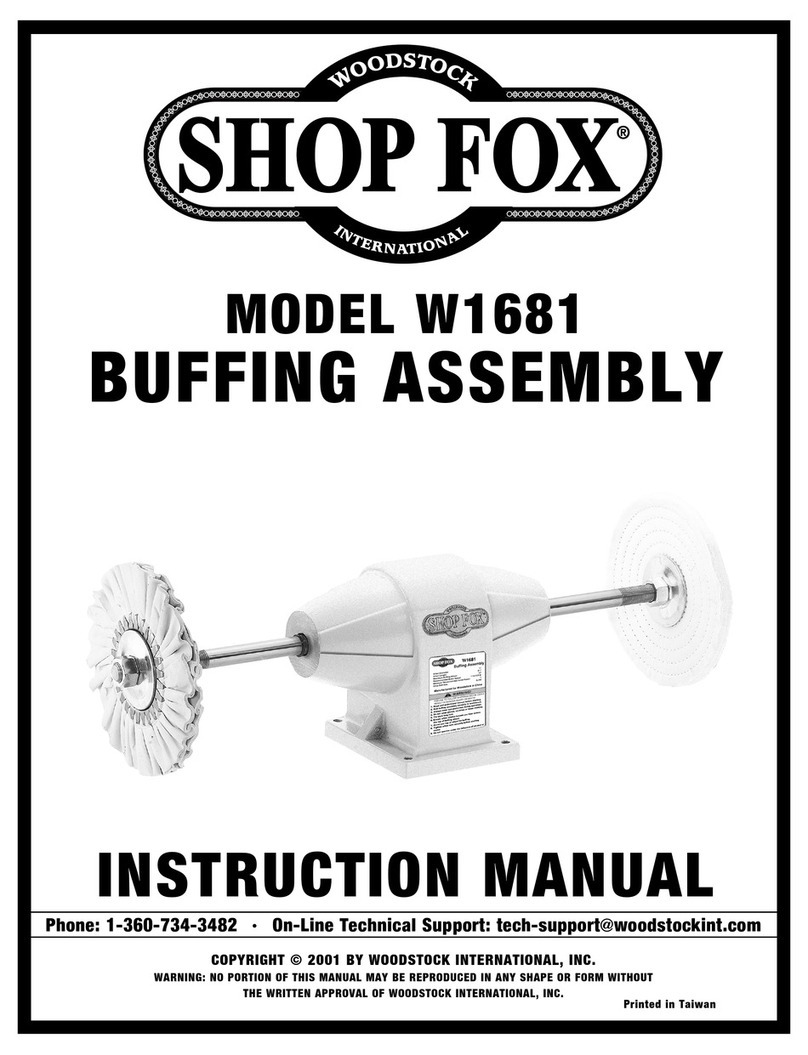
Woodstock
Woodstock H3559 instruction manual
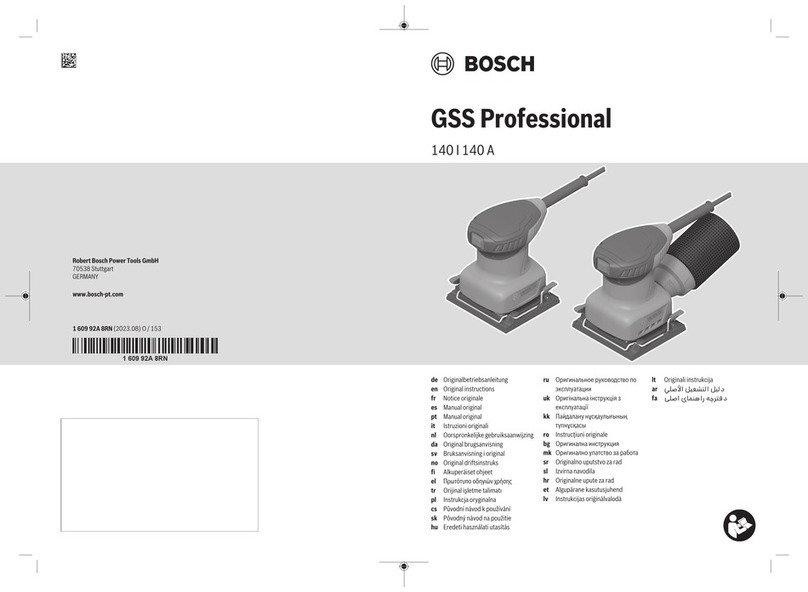
Bosch
Bosch Professional GSS 140 Original instructions

Meister
Meister MFS280 Translation of the original instructions
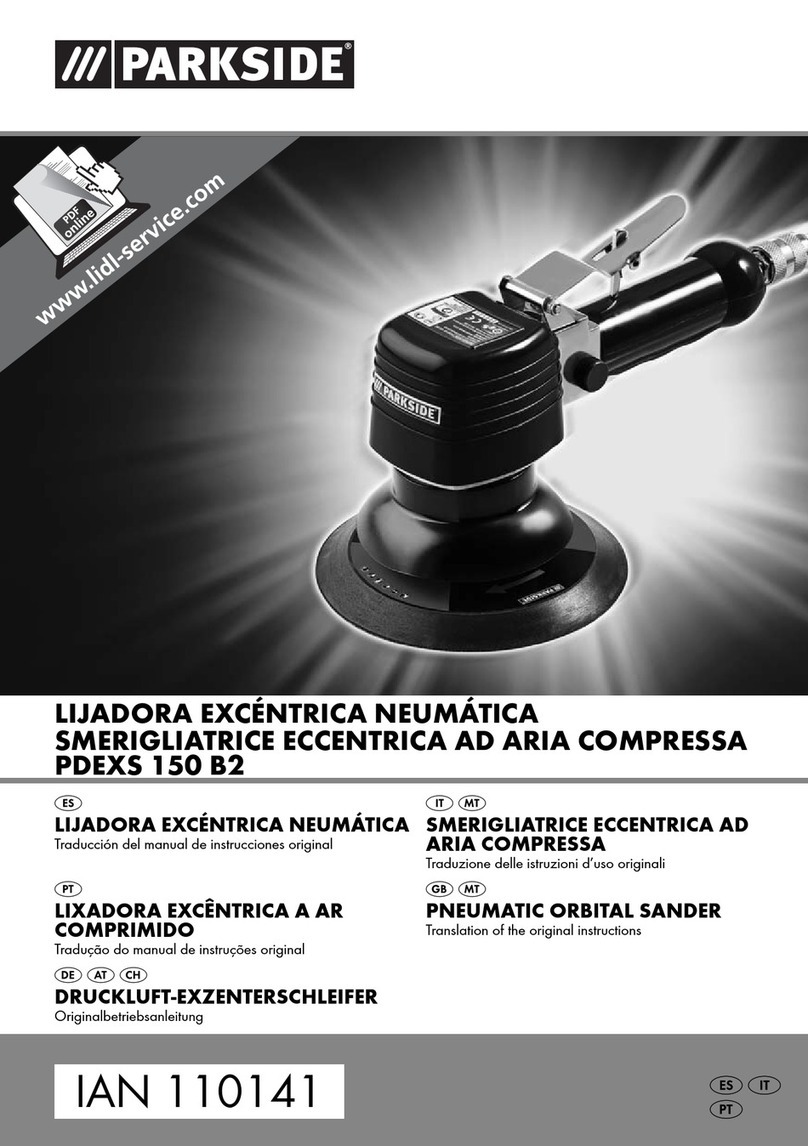
Parkside
Parkside PDEXS 150 B2 Translation of the original instructions
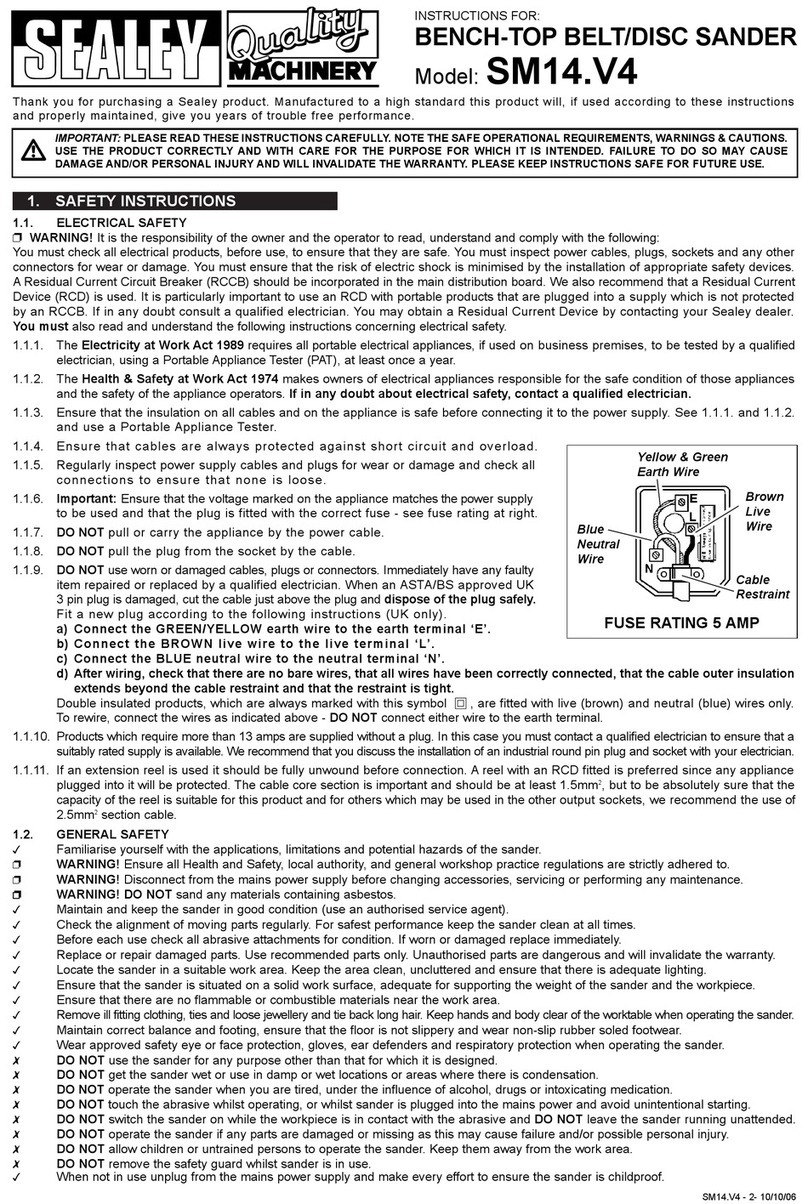
Sealey
Sealey SM14.V4 instructions



